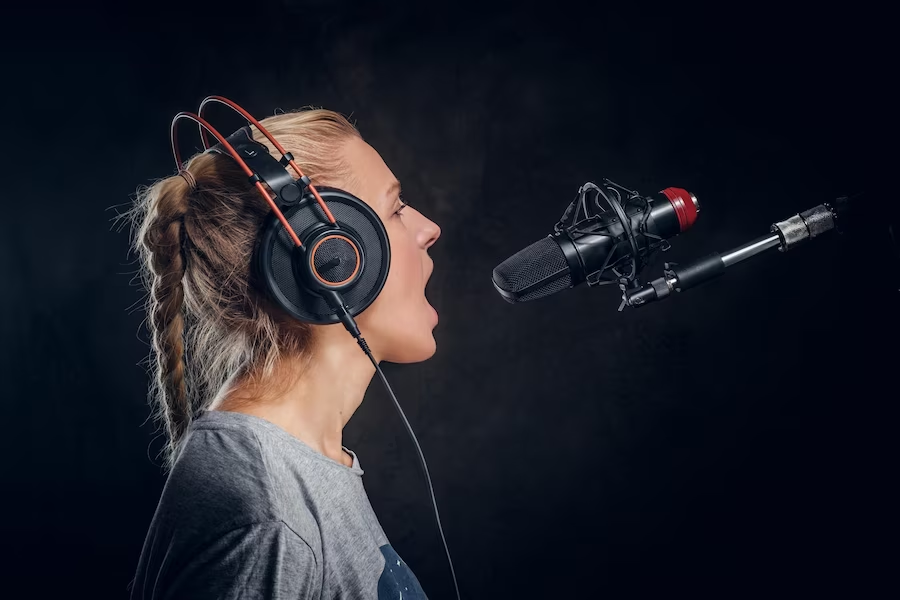Understanding how vocal resonance, projection, and tone function in our daily communication can vastly enhance our overall effectiveness as communicators. These elements, when thoroughly understood and utilized, can empower our vocal delivery, making it more compelling and commanding.
In-Depth Analysis of Vocal Resonance
Before delving into the intricacies of vocal resonance, it’s important to understand the key anatomical players involved. Here is a snapshot of the critical components:
- Vocal Cords: Located within the larynx, these are the initial producers of sound;
- Pharynx: The throat space that amplifies the sound;
- Oral Cavity: The mouth area that adds tonal qualities;
- Nasal Cavity: The nose area that modifies the tonal quality.
Vocal Cords: The Genesis of Sound
The journey of sound starts with the vocal cords. They are composed of two main layers: the muscle (thyroarytenoid) and a cover that is primarily mucous membrane. These components have properties that contribute to their vibratory behavior.
Key factors related to the vocal cords include:
- Length: Affecting the pitch of the voice. Longer vocal cords produce lower pitched sounds;
- Thickness: Influencing the vocal quality. Thicker vocal cords lead to a deeper, fuller voice;
- Tension: Regulating the speed at which vocal cords vibrate. Higher tension results in a higher pitched sound.
These factors determine the initial sound produced, a raw version which then gets refined as it travels through the vocal tract.
The Vocal Tract: Sculpting the Sound
The vocal tract manipulates the raw sound produced by the vocal cords to create the final voice we hear. This is achieved by adjustments in the vocal tract’s configuration, specifically, the positions of the lips, tongue, and soft palate.
Key manipulations in the vocal tract include:
- Pharynx adjustments: By widening or narrowing the throat, we can affect the voice’s volume and depth;
- Oral Cavity alterations: The size and shape of the oral cavity, regulated by the tongue’s position, influence the voice’s brightness and articulation;
- Nasal Cavity resonance: The use of nasal cavities can give voice a distinct brightness or a ‘nasal’ quality.
The voice’s final resonance is a combination of these manipulations, which create a balance of frequencies that gives each voice its uniqueness.
Harmonics and Formants: The Acoustics of Resonance
Harmonics and formants are two vital concepts in understanding vocal resonance. Harmonics are the multiple frequencies produced by the vibration of the vocal cords, whereas formants are the frequency regions that are amplified due to the shape and size of the vocal tract.
- Harmonics: The fundamental frequency (the lowest, and usually most dominant frequency) is determined by the vocal cord’s vibration speed. This frequency and its multiples form the harmonic series of the voice;
- Formants: These are the resonant frequencies of the vocal tract. The vocal tract enhances certain frequencies from the harmonic series, and these peaks in the spectrum are the formants.
The first two formants, F1 and F2, are crucial in vowel formation, while higher formants contribute to the voice’s unique timbre.
Factors Affecting Vocal Resonance
Several factors can influence the resonance of a voice. These include:
- Physical anatomy: The size and shape of the vocal tract can dictate the voice’s natural resonance. Larger spaces generally create deeper, louder voices;
- Health: Conditions like laryngitis or sinus congestion can significantly impact resonance;
- Technique and Training: With appropriate training, individuals can manipulate their vocal tract to achieve desired resonance effects;
- Emotion: Emotional states can affect the tension in the vocal apparatus, thus changing vocal quality.
Vocal Resonance in Singing and Speech
Vocal resonance is key to both singing and speech. In singing, vocalists use resonance to amplify their voice without straining their vocal cords, creating a rich and full sound. They also manipulate resonance to produce different tonal qualities, allowing them to express various emotions through their voice.
In speech, resonance plays a significant role in creating vocal identity. Each person’s unique vocal tract shape and manipulation patterns create a distinct resonance, contributing to their individual vocal fingerprint. Additionally, resonance aids in articulation and intelligibility of speech sounds.
Factors Affecting Vocal Resonance

Vocal resonance refers to the quality and richness of sound produced by the human voice. Several factors play a vital role in shaping vocal resonance, determining the unique timbre and tone of an individual’s voice. Below are the key factors influencing vocal resonance, presented in a detailed format:
Shape of the Vocal Tract
The vocal tract consists of various structures such as the lips, tongue, pharynx, and soft palate. The configurations and movements of these components significantly impact the resonating sound. Different shapes within the vocal tract allow for the production of various vowel and consonant sounds.
| Articulators | Function |
|---|---|
| Lips | Shape the opening of the vocal tract and affect the clarity of certain sounds. |
| Tongue | Controls the flow of air and shapes the resonating cavities, influencing vowel sounds. |
| Soft Palate | Also known as the velum, it can be raised or lowered to modify resonance and airflow through the nasal cavity. |
| Pharynx | Acts as a resonating chamber and plays a crucial role in determining the voice’s tonal qualities. |
Size of the Vocal Tract
The dimensions of the vocal tract determine the resonant frequencies of the vocal folds, impacting the voice’s depth and volume. Larger vocal tracts generally produce lower-pitched sounds, while smaller tracts tend to create higher-pitched sounds.
| Vocal Tract Size | Voice Characteristics |
|---|---|
| Longer | Lower-pitched voice with a richer tone. |
| Shorter | Higher-pitched voice with a brighter tone. |
Vocal Cord Tension
The tension in the vocal cords affects the pitch of the voice. When the vocal cords are tightened, they vibrate at a higher frequency, resulting in a higher-pitched sound. Conversely, when the vocal cords are more relaxed, they vibrate at a lower frequency, producing a lower-pitched sound.
| Vocal Cord Tension | Voice Characteristics |
|---|---|
| Tighter | Higher-pitched voice. |
| Looser | Lower-pitched voice. |
Breathing Techniques
Effective breath control is crucial for vocal resonance, as it allows for steady sound production and modulation. Proper breathing techniques provide the necessary airflow and support for sustaining notes and controlling volume.
Breathing techniques for vocal resonance include:
- Diaphragmatic Breathing: Engaging the diaphragm to draw in deep breaths, maximizing air capacity for longer phrases and better vocal control;
- Sustainable Breath Management: Learning to use air efficiently to maintain consistent vocal power and avoid strain.
- Controlled Exhalation: Gradually releasing air to create dynamic variations in volume and expression;
- Breath Support during Phonation: Maintaining proper breath support while producing sound to avoid vocal fatigue and maintain resonance.
The Intricacies of Vocal Projection

Vocal projection is about the reach of your voice—how far your sound can travel and how well it is heard by others without you having to shout. This capacity is essential in various settings, from public speaking engagements to everyday conversations.
Underpinning Principles for Vocal Projection
- Diaphragmatic Breathing: Diaphragmatic breathing or “belly breathing” is an effective technique for enhancing vocal projection. It involves drawing in more air into the lungs by expanding the diaphragm (a dome-shaped muscle under your rib cage) during inhalation. This action increases your breath support, empowering your voice to reach further;
- Articulation: Proper pronunciation and articulation of words contribute significantly to how well others hear and understand you. It involves clear enunciation, with emphasis on consonants and properly voiced vowels;
- Voice Support: Voice support or ‘placement’ refers to using the body’s natural resonators, including the chest, throat, mouth, and nasal cavities. By directing your voice through these spaces, you can amplify and project your voice more efficiently;
- Confidence: Believe in what you say. Your mental state can affect your physiological state, and vice versa. Hence, exuding confidence can naturally improve your voice’s strength and projection.
Table: Vocal Projection Techniques
| Technique | Description |
|---|---|
| Breathing Techniques | Diaphragmatic breathing for optimal breath support. |
| Posture | Stand/sit straight and relax your shoulders for a more open respiratory system. |
| Articulation | Clear pronunciation and enunciation of words. |
| Confidence | Exuding belief and certainty in your speech. |
The Power of Vocal Tone
The tone of voice represents the emotional context or attitude behind our words. A well-modulated vocal tone can significantly impact how our messages are received by the listeners.
Influencing Factors for Vocal Tone
- Emotion: Your current emotional state can affect the tone of your voice. For example, happiness tends to lead to a more energetic and vibrant tone, while sadness or tiredness can lead to a softer, slower speech;
- Physical State: If your body is relaxed, your voice will reflect that ease, leading to a warm, rich tone. Conversely, if your body is tense, your voice may come off as strained or harsh;
- Social Context: The social setting and the nature of your relationship with the listener can also influence your vocal tone. For instance, the tone used in a formal business meeting would differ significantly from that used in a casual chat with friends.
Vocal Tone Enhancement Techniques
- Relaxation Techniques: Regular practice of relaxation techniques, such as meditation and progressive muscle relaxation, can help reduce bodily tension, leading to a more pleasant vocal tone;
- Pitch Variation: Monotone speech can be boring to listeners. Incorporate pitch variations to make your voice more engaging and to emphasize important points;
- Resonance Exercises: Using the different resonating spaces in your body (chest, throat, mouth, nasal cavities) can add depth and richness to your tone;
- Vocal Modulation: Change the speed, volume, and pitch of your voice to express different emotions. Modulating your voice can make your speech more captivating and expressive.
Practicing Vocal Exercises

Vocal exercises are the key to improving and maintaining vocal resonance, projection, and tone. Here are some exercises to help you get started.
- Humming: Start with a relaxed humming sound, feeling the vibrations in your chest, throat, and face. This exercise enhances resonance and warms up the voice;
- Lip Trills: Blow air through your lips, causing them to vibrate or “trill.” This technique aids in breath control and relaxation of the vocal cords;
- Sirens: Make a ‘siren’ sound, starting from the lowest pitch you can comfortably produce, going up to the highest pitch, and then back down. This exercise helps with vocal range and resonance;
- Tongue Twisters: Practice saying tongue twisters at a comfortable speed, gradually increasing the speed while maintaining clear articulation. This exercise improves diction and speech clarity;
- Reading Aloud: Choose a passage and read it out loud, emphasizing different words, altering your pitch, volume, and speed. This exercise helps improve vocal modulation and expressiveness.
Conclusion
In harnessing the power of vocal resonance, projection, and tone, understanding, practice, and consistency are your most valuable tools. Begin by knowing your voice, invest time in regular practice, be patient with your progress, and before long, you’ll witness a transformation in your vocal abilities, enhancing your overall communication effectiveness.
FAQ
Start by understanding your body’s natural resonators—your chest, throat, mouth, and nasal cavities. Perform vocal exercises that help you ‘feel’ the vibrations in these areas when you speak or sing. Consistent practice is key to mastering vocal resonance.
Breathing is the fundamental support system for your voice. Diaphragmatic breathing allows for a greater intake of air, providing more power to your voice and improving its projection.
Absolutely! Your emotional state can significantly influence your vocal tone. Excitement can raise your pitch, stress or nervousness can make your voice shaky, and happiness can make your voice more vibrant.
Yes, vocal exercises are essential. They help condition your vocal cords, resonance spaces, and muscles to work in harmony, enabling you to improve the quality of your voice and maintain vocal health.